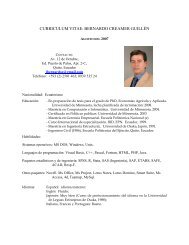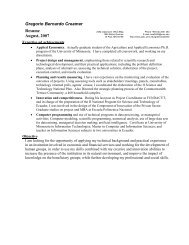Water-Quality Trading: Can We Get the Price of Pollution Right?
Water-Quality Trading: Can We Get the Price of Pollution Right?
Water-Quality Trading: Can We Get the Price of Pollution Right?
Create successful ePaper yourself
Turn your PDF publications into a flip-book with our unique Google optimized e-Paper software.
control purchased from source j to <strong>of</strong>fset pollution at source i, r ki is <strong>the</strong> amount <strong>of</strong> pollution controlfrom source i that is kept by source i to meet <strong>the</strong> zonal standard ¯Z i , and r si is <strong>the</strong> amount <strong>of</strong>pollution control sold by source i. As Hung and Shaw observe, <strong>the</strong> TRS possesses two advantagesover o<strong>the</strong>r trading schemes. The first is that each discharger must participate in only a singlewatershed-wide permit market, so that transaction costs are low. The second is that <strong>the</strong> regulatorallocates initial zonal discharge permits ¯Z in such a way that <strong>the</strong> ambient environmental constraints¯X are satisfied exactly at <strong>the</strong> initial allocation.One can rewrite constraint (5) to obtain Hung and Shaw’s trading constraint (<strong>the</strong>ir equation(5)):e i ≤ ¯Z i + ∑ i−1τ jir ji − ∑ nr ij, (9)j=1 j=i+1where r ij is <strong>the</strong> net amount <strong>of</strong> zonal discharge permits sold by source i to source j. This constraintmeans that any discharger can buy permits only from upstream zones and sell permits only todownstream zones. Because sources can trade permits at exchange rates τ, in any TRS equilibrium(including <strong>the</strong> boundary case), for any j > i, <strong>the</strong> spatially explicit prices <strong>of</strong> permits must satisfyτ ij p j = p i . (10)The economic implications <strong>of</strong> this equality are substantial. Even if a high-cost source is locatedupstream <strong>of</strong>, or on a different branch from, a low-cost source, this constraint strictly prohibits anycost-minimizing trade between <strong>the</strong>m: τ ij = 0 for i > j. This might seem justifiable at first on <strong>the</strong>grounds that water flows downstream, so that any downstream pollution reduction or a reductionon a different branch has no effect on <strong>the</strong> concentration at <strong>the</strong> upstream location. However, <strong>the</strong>marginal damages <strong>of</strong> pollution from dischargers located in <strong>the</strong> different branch can be higher thanthose located in <strong>the</strong> upstream, particularly when damages are nonlinear. If so, <strong>the</strong>n more abatementby low-cost firms in <strong>the</strong> different branch in exchange for less abatement at high-cost firms in <strong>the</strong>upstream would be Pareto improving. The TRS, <strong>the</strong>n, disallows some trades that would increasewelfare. <strong>We</strong> shall return to this point in Section 5 when presenting <strong>the</strong> results <strong>of</strong> our numericalwork.According to Proposition 1, <strong>the</strong> solution to program (2) also solves program (1), regardless <strong>of</strong>branching or nonlinear damages. The question is whe<strong>the</strong>r Hung and Shaw’s TRS equilibrium isguaranteed to achieve <strong>the</strong> solution to program (2). Our next result, Proposition 2, shows that <strong>the</strong>answer is no. 8 There are situtions, not unusual in actual practice, in which <strong>the</strong> outcome <strong>of</strong> <strong>the</strong>TRS is ei<strong>the</strong>r indeterminant (<strong>the</strong> permit-allocation scheme breaks down) or inefficient (it fails tosolve program (2)).<strong>We</strong> first turn our attention to an important property <strong>of</strong> <strong>the</strong> transfer coefficients. This propertyis satisfied in Hung and Shaw’s numerical example, but is not o<strong>the</strong>rwise noted in <strong>the</strong>ir paper. Thecoefficients must be associative. Intuitively, this means that <strong>the</strong> amelioration or degradation <strong>of</strong> aunit <strong>of</strong> pollutant between zone i and zone i + 1 is <strong>the</strong> same whe<strong>the</strong>r that unit was emitted at zone ior arrived from upstream. Formally, associativity is defined as follows.Definition. Given a matrix T = {τ ij } <strong>of</strong> transfer coefficients, say that T is associative if for alli, m, and k, τ im τ ki = τ km . Say that T is non-associative if <strong>the</strong>re exist i, m, and k for whichτ im τ ki ≠ τ km .8 <strong>We</strong> have also shown that when <strong>the</strong>re are multiple adjacent critical zones, <strong>the</strong> original TRS allocation schemebreaks down. For this situation we have derived a modified version <strong>of</strong> <strong>the</strong> TRS in which permits are allocated startingat <strong>the</strong> downstream-most source and proceeding upstream. Our modified version achieves <strong>the</strong> optimal outcome in <strong>the</strong>face <strong>of</strong> adjacent critical zones. The pro<strong>of</strong> <strong>of</strong> this claim is available upon request. It appears that <strong>the</strong> TRS cannot besalvaged in <strong>the</strong> case <strong>of</strong> a critical zone at <strong>the</strong> confluence <strong>of</strong> branches.7



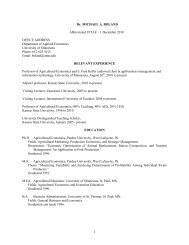
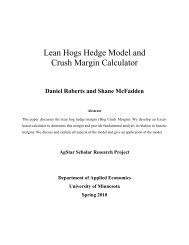
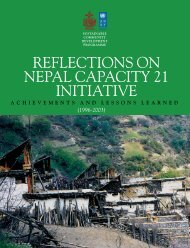
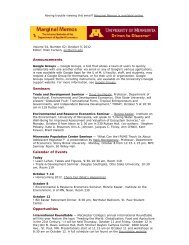


![Publications Since 2000[1].docx](https://img.yumpu.com/30237513/1/190x245/publications-since-20001docx.jpg?quality=85)

